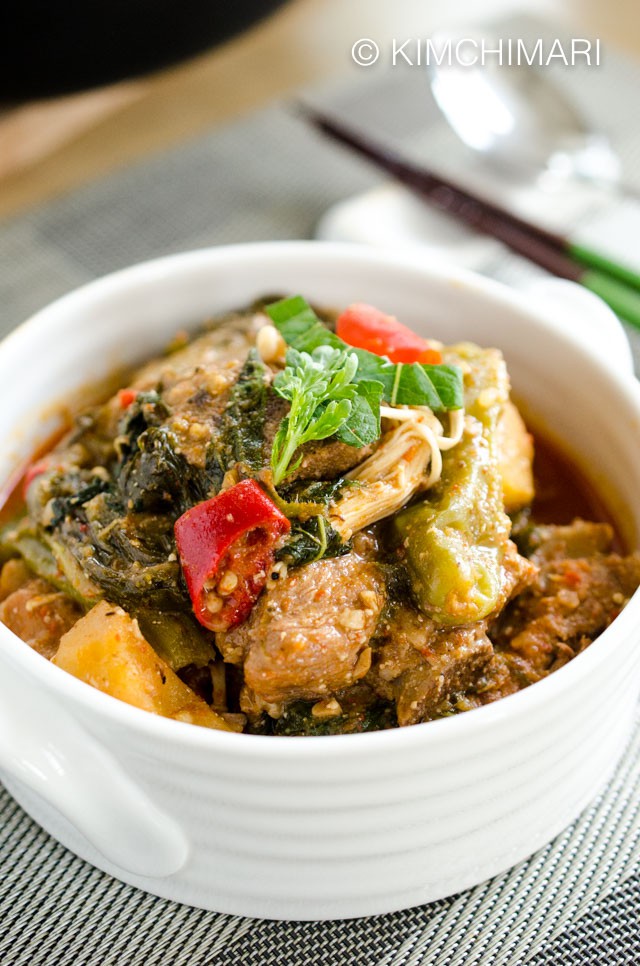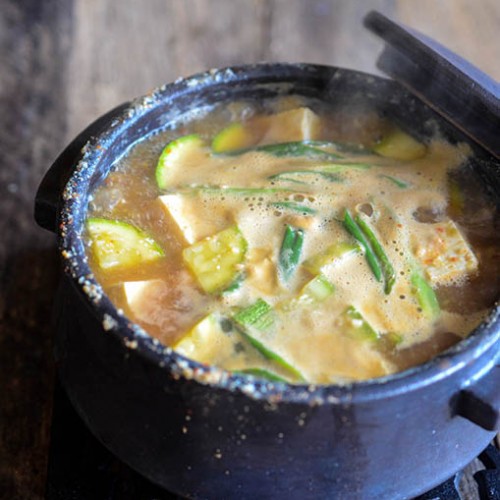7 recipes using Doenjang – a traditional and unique Korean seasoning ingredient made with fermented soybeans. These recipes include classic soups and stews, plus an Instant Pot option.

If you love Doenjang then I think it would be safe to say that you REALLY love Korean food. Pronounced DWEN-jaahng, it is a paste made from fermented soybeans and salt, which is the unspicy brother to Gochujang. 😂 Or should I say Gochujang is a spicy sister to this umami-packed soybean paste?? HAHAHA…
Similar to Miso but funkier and somewhat pungent, it is often used to season sauces, soups, and stews. Along with Korean red chili pepper paste gochujang, Deonjang is one of the most essential ingredients in authentic Korean cooking.

Doenjang Jjigae is probably the first dish that comes to mind for most people if they are asked about recipes using Doenjang. A traditional stew that really highlights the umami flavor of Doenjang, you must try it if you haven’t yet!! You can find my recipe for that on the list below, and a few other classic Korean dishes using doenjang. It should be easy to find doenjang at Korean supermarkets, and you can start trying these recipes right away!
If you’re interested to learn more about doenjang, I have a comprehensive Doenjang Guide post to help you get to know it better. It includes a buying guide and answers questions about the different types available.
Heres’ my list of 7 Recipes Using Doenjang!
Lettuce Wrap Sauce (Ssamjang)

Korean lettuce wrap (ssam) is incomplete without ssamjang. Made with doenjang, gochujang, garlic, green onion, sesame seeds, and sesame oil, ssamjang adds the final flavor punch to the wrap. It is the essential condiment that brings the rice, meat, and lettuce together in the wrap.
Boiled Pork Belly Wrap (Bossam)

In the tradition of Korean lettuce wrap, Bossam wraps the unctuous boiled pork belly cooked in Doenjang, spicy kimchi radish salad, and crunchy pickled cabbage leaves in a packet of heavenly deliciousness. It’s great for parties.
Cabbage Soybean Paste Soup (Baechu Doenjang Guk)

This simple soup has meat, vegetables, and a whole lot of flavor from Doenjang. It can be made in about half an hour. Best served with rice for a complete meal and a little kimchi on the side. It’s the ultimate comfort food for Koreans. Healthy and satisfying for the whole family.
Radish Soup with Soybean Paste (Mu Doenjang Guk)

Light and soothing, this meatless soup (traditionally made with anchovy stock but you can use vegetable stock to make it vegan) is simply packed with the delectable umami flavor from our star ingredient. For meal planning, make a large pot and reheat as needed. It actually tastes better the next day!
Soybean Paste Stew (Doenjang Jjigae)

One of the great classic Korean dishes, this traditional Doenjang stew is uniquely flavored thanks to the key ingredient. It’s really easy to cook and makes a great side dish for any meal. The Doenjang serves as a great foundation to any ingredients you throw into the stew – vegetables, seafood like shrimp, shellfish and even squids, mushrooms, beef and more. Koreans love to pair it with BBQ and jeon. Savor the taste and aroma!
Spicy Pork Bone Stew with Potatoes (Gamjatang)

Last on our list of recipes using Doenjang, Gamjatang is a wonderfully hearty and spicy Korean stew made with pork neck bones (or pork ribs) and potatoes. Doenjang goes into the seasoning sauce along with Korean red chili paste (gochujang), chili flakes (gochukaru), anchovy sauce, and soup soy sauce. Oh, the flavors!
Instant Pot Gamjatang

For speed and convenience, cook Gamjatang in the Instant Pot. Pork bones usually need a long time to cook, but the Instant Pot makes it simpler and faster to cook without compromising all the good flavors. This is definitely a must-try doenjang recipe for meat lovers!
I hope you’ll enjoy these 7 recipes using this fermented Korean soybean paste. If you try them, please rate my recipes and leave some comments. Feel free to share with me on INSTAGRAM by tagging @kimchimari.
XOXO ❤️
JinJoo
CONNECT WITH ME on FACEBOOK, PINTEREST, and INSTAGRAM. And join my FACEBOOK GROUP to meet other Korean food enthusiasts just like you!





















Lots of information here on korean base basics to asian recipes. I’ve just subscribed so hopefully more recipes will come through on the newsletter and give me more korean food for thought in my journey and passion of Korefood.
I make jjajamyeon-like noodles. I like it better than the caramel color sauce.
Hi JinJoo,
Do different types of doenjang have different uses?
I’ve been using a Ch*ng Jung One brand sunchang doenjang that’s a very dark shade of brown to try to make doenjang jjigae but the end result looks very different to the much lighter brown stews I get at restaurants, so I wonder if I need to use a different brand. Thank you!
Well, not really – you can use the same basic Doenjang for everything but these days they do sell Doenjang that’s pre-seasoned specifically for making Jjigae. The color is not that important although the very dark brown could possibly mean that it’s too old. You can read all about it in my post – https://kimchimari.com/doenjang-how-to-buy-how-its-made/
Hope that helps.
Hi Jon Joo
I have a tub of doenjang that have hardened, forgotten and hidden at the back shelve of my fridge for several years. It taste and smell good but very salty. Do I use it directly or soften the whole tub first by adding salted water/soy sauce?
Tq
So the standard way to revive an old dried up Doenjang is to cook soybeans, mash them and mix them in – along with some anchovy broth or water from cooked soybeans. But this is for Doenjang that you made at home. For you since this is storebought and you probably have just a little and don’t want to go thru the trouble, you can try adding some soju and anchovy broth and mix. Good luck!
Hi,
Sorry for being s***** do you keep doenjang paste in a plastic pot in the fridge? Could I keep it out or transfer it to a earthen pot?
What did they used to do back in the days?
Many thanks,
Back in the days Doenjang was kept in onggi (earthen pot) outside. But we are talking about Doenjang that was homemade with active fermentation with lots of sodium. Today it depends on the kind of Doenjang you have whether they have live cultures or not. Generally it would be safer to keep in the fridge as that will slow down the fermentation. Good lucj!